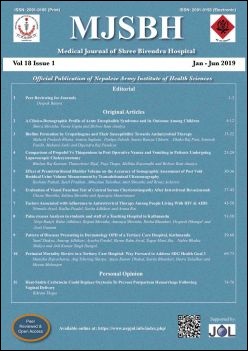Biofilm Formation by Uropathogens and Their Susceptibility Towards Antimicrobial Therapy
Keywords:
Antibiotic resistance, Biofilm, Urinary tract infection, UropathogensAbstract
Introduction: Urinary tract infection (UTI) is the most common health care associated infection caused by various pathogenic bacteria. Biofilms are communities of bacteria that are held together by exopolymeric substances that protect against the antimicrobial therapy and other environmental assaults. The aim of this study was to estimate the prevalence of biofilm forming bacteria in Nepalese population and to study the emergence of antimicrobial resistance among biofilm producing bacteria in comparison to non-biofilm producing bacteria.
Methods: A total of 785 clean-caught-mid-stream urine samples were collected. After isolation and identification of uropathogens, they were further processed for detection of biofilm formation by two methods (Congo Red Agar method and Tissue Culture Plate method) as well as for antibiotic sensitivity test.
Results: Out of total collected samples, 12.74% were found to be associated with UTI, among them 67% were Escherichia coli, 10% were Klebsiella spp, 7% were Pseudomonas spp, 6% were Staphyloccous aureus, 4% were Enterobacter spp, 3% were Proteus spp, 2% were Citrobacter spp and remaining 1% was Staphylococcus saprophyticus. Among isolated organisms, the ratio of bioflim positive organism to bioflim negative organism was found to be 9:11. Nitrofurantoin, Tobramycin, Chloramphenicol, Amikacin and Imipenem were found to be significantly more sensitive in biofilm negative bacteria as compared to biofilm positive bacteria with p values of 0.000, 0.001, 0.000, 0.000 and 0.001.
Conclusions: The prevalence rate of multidrug resistance in bacterial uropathogens was higher in biofilm producers as compared to non-biofilm producers. Biofilm forming characteristic of bacteria make them more resistant to antibiotics.
Downloads
Downloads
Published
How to Cite
Issue
Section
License
This license enables reusers to distribute, remix, adapt, and build upon the material in any medium or format for noncommercial purposes only, and only so long as attribution is given to the creator.




